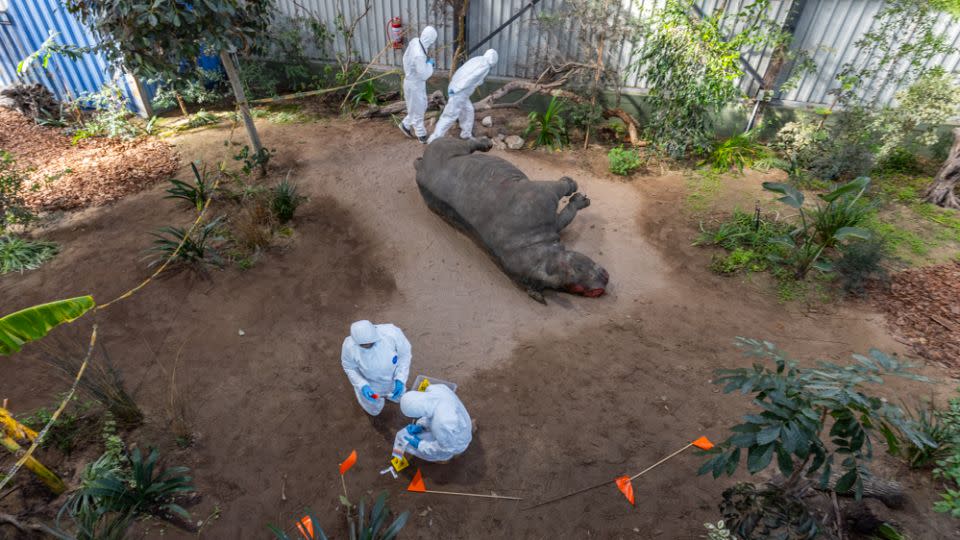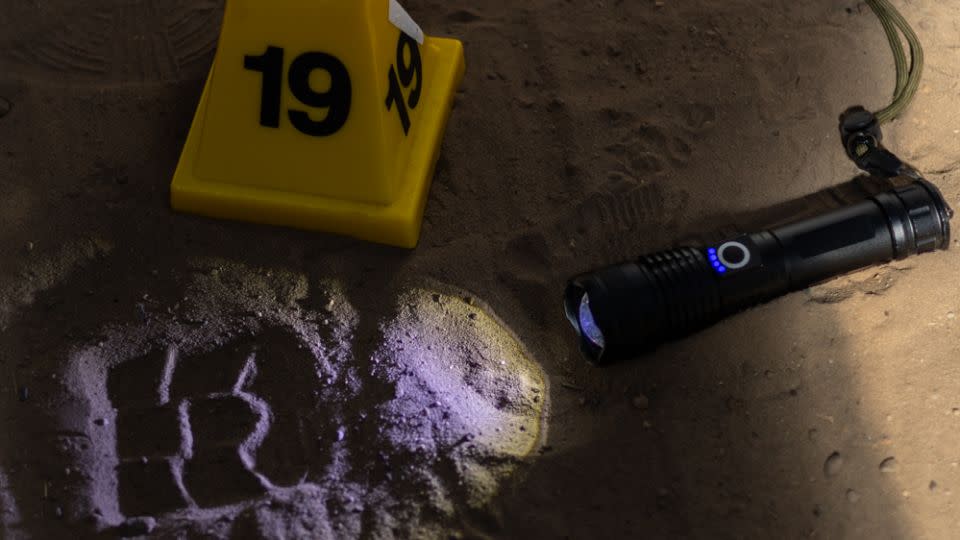Fake blood and stuffed animals: How wildlife forensics could help to convict poachers
Editor’s Note: Call to Earth is a CNN editorial series committed to reporting on the environmental challenges facing our planet, together with the solutions. Rolex’s Perpetual Planet Initiative has partnered with CNN to drive awareness and education around key sustainability issues and to inspire positive action.
A case of a rhino with a bullet hole through its head, a poisoned giraffe and a maimed lion are all crime scenes you might find you might find at the Wildlife Forensics Academy (WFA), an hour’s drive north of Cape Town, South Africa.
On a mission to tackle poaching, the WFA recreates wildlife crimes in a warehouse and students and rangers dressed in hazmat suits are taught how to handle the evidence.
Across the world, wildlife crimes – including animal trafficking and poaching – are on the rise and are a major threat to the planet’s biodiversity. In Africa, rhinos are a prime target, with around 10,000 lost to poaching in the last decade, the majority in South Africa. Almost 500 rhinos were poached in the country in 2023, with more than 300 from within KwaZulu-Natal province, home to Hluhluwe-iMfolozi Park. Yet the province only recorded 49 related arrests and seized just 13 firearms.
By providing forensics training, Greg Simpson, co-founder of the WFA, hopes to increase the rate of successful convictions. Often, he says, wildlife crimes happen in remote areas without witnesses and first responders can accidentally disrupt the scene and contaminate evidence. As a result, the culprit isn’t caught or punished.
“It’s really important to give people skills so that they can collect evidence … that can be used in an investigation and hopefully down the line will end up in a prosecution,” he says.

Crime scene simulation
The facility tries to make the training experience as realistic as possible. It uses life-size animals preserved by taxidermy, and some are marked with bloody wounds made with red paint. Besides the corrugated iron walls and roof, the warehouse looks like a typical dry African landscape, with sandy terrain and a scattering of plants. There is a poachers’ house and truck, ready to be searched and swabbed for fingerprints, and footprints lie on the ground, ready to be measured and identified.
Once the crime scene has been investigated, the students are taught how to chemically analyze the evidence at an on-site laboratory. The lessons culminate in a replica courtroom where they practice presenting the evidence at trial and undergo cross-examination.
“The purpose of cross-examination is to test the credibility, the trustworthiness of evidence. And unless you can survive it, the court might not accept your evidence,” says Phil Snijman, director of education at the WFA and former state advocate and prosecutor.
Fingerprints, DNA samples, ballistics (when a weapon is matched to a cartridge), shoe tracks can all be discounted by the court if they have not been correctly sealed, photographed or documented, he explains. And while he does not expect the course to make students and rangers forensic experts, he believes that it will help them to preserve the evidence correctly if they are ever the first responders to a crime scene.
Boosting convictions
Launched in 2022, the WFA attracts university students, such as those studying veterinary or biomedical sciences, and wildlife rangers from all over the world to its one to four-week courses. This year, it expects to train around 200 people. One of them is Leita Mkhabela, a ranger from the all-female Black Mamba anti-poaching unit that operates in Greater Kruger, a collection of private game reserves in northeast South Africa, who attended a course in April.
“This is something we come across every day, we have a high rate of rhino poaching,” she says. “We have so many poachers that have walked free in court because rangers didn’t collect enough evidence. It’s really important for rangers to get this knowledge.”
Mkhabela plans to take back all that she has learned to her colleagues so that they can implement the techniques in the bush. She believes that increasing the rate of convictions will act as a deterrent for poachers.

There are signs that the training is leading to convictions. According to the WFA, a ranger reported that since doing the course, he was able to collect traces of poison at a crime scene involving wild dogs, and police were confident they would be able to arrest and convict the poachers as a result.
Other forensic laboratories have been set up across the continent, in countries such as Malawi and Botswana. One initiative, led by the International Fund for Animal Welfare (IFAW), ran four workshops during 2023 and early 2024, training 80 wildlife rangers, investigators, and intelligence officers from the Kenya Wildlife Service on collecting and presenting evidence in court. In the first quarter of this year, IFAW reported 32 wildlife crime cases being presented in court and 24 people accused of wildlife crimes awaiting prosecution. Previously, these cases would have been dropped due to a lack of sufficient evidence, it says.
Kevin Pretorius, director of the Green Law Foundation and a practicing attorney at the High Court of South Africa, who specializes in criminal and environmental law, and is not involved with WFA, says that one of the main hurdles in convicting wildlife crimes is the “admissibility of evidence,” especially since the charge must be proven “beyond reasonable doubt.”
“The training of a cohort of people that understand the value of evidence, and that a crime scene tells a story, and that story can assist the investigator in linking the perpetrator to a crime, is always valuable,” he says.
For the WFA, assisting law enforcement is its central mission, but it also hopes to raise awareness of the threats presented by the illegal wildlife trade and why it should be treated as a priority. “It’s a threat to biodiversity, it’s a threat to human health,” says Simpson. “If we can improve knowledge around this, that would be really valuable.”
For more CNN news and newsletters create an account at CNN.com


